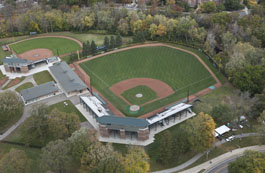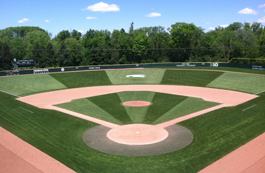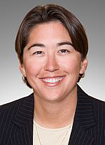Dec. 23, 2013
Spartans Earn STMA
Award
By Sean Ryan
CollegeBaseballInsider.com
Co-Founder
sean@collegebaseballinsider.com
@collbaseball
 In
November, the Sports Turf Managers Association (STMA), the
professional association for 2,600 men and women who manage
sports fields worldwide, announced its 2013 “Field of the Year
Award” winners. In
November, the Sports Turf Managers Association (STMA), the
professional association for 2,600 men and women who manage
sports fields worldwide, announced its 2013 “Field of the Year
Award” winners.
Michigan State’s Kobs Field at McLane Stadium was cited as tops
in college baseball. CBI caught up with Amy Fouty, the athletic
turf manager, and Jared Knoodle, the groundskeeper, of Michigan
State about the award and what goes into taking care of a
baseball field.
First Inning – How does it feel to be named the best college
baseball field for 2013?
It is
always an honor to be selected by your peers as the “best of the
best.” We are very proud to pursue excellence in our area each
day on behalf of our University, Department, and Turfgrass
Management program here at Michigan State University (MSU). As
one of our former interns always said, “We set the stage for
greatness.” We strive each day for the success of our
student-athletes and athletic programs.
Second Inning – Describe the process for being selected Field of
the Year.
A
panel
of
16
judges
independently
scored
entries
based
on
playability,
appearance
of
surfaces,
utilization
of
innovative
solutions,
effective
use
of
budget
and
implementation
of
a
comprehensive
agronomic
program.
Judges
may
not
award
a field
in
each
category.
Winning
fields
will
be
featured
in
a
2014
issue
of
Sports
Turf
Magazine.
Awards
will
be
presented
at
the
25th
STMA
Conference
&
Exhibition
in
San
Antonio,
Texas
January
21-24,
2014.
The
2013
event
was
one
of
the
most
well-attended
in
the
association’s
history,
with
a record
168
exhibitors
and
1,600
attendees.
 Third
Inning – Kobs Field at McLane Baseball Stadium has been
transformed over the past seven or eight years. Describe some of
what went into this award. Third
Inning – Kobs Field at McLane Baseball Stadium has been
transformed over the past seven or eight years. Describe some of
what went into this award.
MSU
students, graduates of our Turfgrass Management program,
coaches, and our administration have all played roles in the
success of our facilities for many years. The field was
renovated in 2006, Amy was the designer and project manager for
the field. Jared was an undergraduate intern at the time and
worked very long hours on the construction process of the field.
Properly constructing a field for our climate and use,
understanding of field conditions, and proper scheduling are all
critical for athletic fields to be maintained successfully over
time. With this year’s flooding of Old College Fields and
challenging weather situations during field use times, we
thought it would be an opportune time to honor our small hard
working grounds crew for their accomplishments and dedication.
Many improvements have been made in and around Kobs Field over
the past eight years which include anew entrance plaza, press
box, stands, indoor hitting and pitching facility, restrooms,
and concessions. Michigan State has invested in the experiences
for both the student-athletes and fans who come to McLane
Stadium.
Fourth Inning – When the field was renovated, was there any
thought of going with artificial turf?
We
really did not consider artificial turf as a viable option for
our program. We renovated our field for 1/4 of what it would
have cost to install an artificial playing surface. We want to
remain true to the game of baseball, as the MLB is doing, by not
installing any more artificial playing surfaces in the league.
As long as we allow for maintenance times between practices,
rentals, and events, we have found a balance to maintain the
facility at a high collegiate level while keeping cost down.
Fifth Inning – What are some keys to maintaining a grass field
and getting it ready for the college season after an East
Lansing winter?
After
fall practice is completed, we prepare the playing surface so it
is ready to go in the spring. This includes mounds being
rebuilt, skin leveled, home plate renovation, grass aeration and
edge trimming. It is critical to have the right grounds staff
with passion, knowledge and experience to keep up with the
maintenance of the field each day. Baseball fields do not
require a lot of funding, just time and skills to do basic
maintenance. We are fortunate that our baseball team does
little things like broom edges, drag the skin and cover mounds
and plates for us each day after use. We can focus on consistent
and quality field conditions rather than clean up.
Sixth Inning – What are other challenges you face that Southern
fields may not?
In one
spring week in Michigan, you can experience anything from
freezing rain, to snow, to rain, or windy-dry conditions. The
field reacts differently to all these environmental situations
and maintaining consistent, safe playing conditions can be very
challenging. We embrace the adversity we experience and like
the challenge in preparation for each game.
Seventh Inning – How did you get into this line of work?
 Amy
- I have been working in turf for 22 years. I began my career at
a golf course taking care of club house ground when I was 17
years old. I worked on the golf side for eight years and
attended MSU, earning a Turfgrass Management degree here in
1996. As time went on, I was given the opportunity to take care
of the daily operations for football and soccer field management
at the University of Michigan for five seasons. The ultimate
opportunity to return to my alma mater came in December of 2003
when I was offered the Athletic Turf Manager position at MSU. I
have been here 10 wonderful seasons and take great pride and
pleasure doing what I love for the University. Amy
- I have been working in turf for 22 years. I began my career at
a golf course taking care of club house ground when I was 17
years old. I worked on the golf side for eight years and
attended MSU, earning a Turfgrass Management degree here in
1996. As time went on, I was given the opportunity to take care
of the daily operations for football and soccer field management
at the University of Michigan for five seasons. The ultimate
opportunity to return to my alma mater came in December of 2003
when I was offered the Athletic Turf Manager position at MSU. I
have been here 10 wonderful seasons and take great pride and
pleasure doing what I love for the University.
 Jared
- After graduating high school, I knew I wanted to attend MSU. I
learned about the Turfgrass Management program and the rest is
history. I love being able to work outside every day and use my
hands and tools to perform a task. With the schooling I received
from MSU and the skills I acquired working for both the San
Francisco Giants and Detroit Tigers, it was great to return to
MSU in 2011 and take care of the Old College Fields complex. I
love the satisfaction of preparing a baseball field early in the
morning and seeing the finished product right before first
pitch. Being able to watch the players play without having to
worry about any issue with the playing surface is very
gratifying. Jared
- After graduating high school, I knew I wanted to attend MSU. I
learned about the Turfgrass Management program and the rest is
history. I love being able to work outside every day and use my
hands and tools to perform a task. With the schooling I received
from MSU and the skills I acquired working for both the San
Francisco Giants and Detroit Tigers, it was great to return to
MSU in 2011 and take care of the Old College Fields complex. I
love the satisfaction of preparing a baseball field early in the
morning and seeing the finished product right before first
pitch. Being able to watch the players play without having to
worry about any issue with the playing surface is very
gratifying.
Eighth Inning – What are three of the biggest mistakes grounds
crews or high school coaches make with their fields?
1.
Overuse would be the primary mistake.
2. Not
having properly trained staff to take care of the facility or
funding for supplies and tools.
3.
Mismanagement of fields due to or during weather events.
Ninth Inning – Complete the sentence…a
baseball field is a sports turf manager’s passion and little
piece of heaven on earth.
(photos courtesy of MSU Media
Relations Office) |